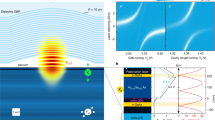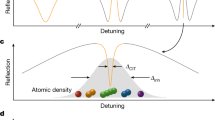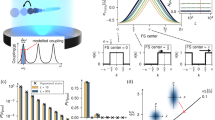Abstract
The ability to control electronic states at the nanoscale has contributed to our modern understanding of condensed matter. In particular, quantum dot circuits represent model systems for the study of strong electronic correlations, epitomized by the Kondo effect1,2,3. We use circuit quantum electrodynamics architectures to study the internal degrees of freedom of this many-body phenomenon. Specifically, we couple a quantum dot to a high-quality-factor microwave cavity to measure with exceptional sensitivity the dot’s electronic compressibility, that is, its ability to accommodate charges. Because electronic compressibility corresponds solely to the charge response of the electronic system, it is not equivalent to the conductance, which generally involves other degrees of freedom such as spin. Here, by performing dual conductance and compressibility measurements in the Kondo regime, we uncover directly the charge dynamics of this peculiar mechanism of electron transfer. The Kondo resonance, visible in transport measurements, is found to be ‘transparent’ to microwave photons trapped in the high-quality cavity, thereby revealing that (in such a many-body resonance) finite conduction is achieved from a charge frozen by Coulomb interaction. This freezing of charge dynamics4,5,6 is in contrast to the physics of a free electron gas. We anticipate that the tools of cavity quantum electrodynamics could be used in other types of mesoscopic circuits with many-body correlations7,8, providing a model system in which to perform quantum simulation of fermion–boson problems.
This is a preview of subscription content, access via your institution
Access options
Access Nature and 54 other Nature Portfolio journals
Get Nature+, our best-value online-access subscription
$29.99 / 30 days
cancel any time
Subscribe to this journal
Receive 51 print issues and online access
$199.00 per year
only $3.90 per issue
Buy this article
- Purchase on Springer Link
- Instant access to full article PDF
Prices may be subject to local taxes which are calculated during checkout




Similar content being viewed by others
References
Goldhaber-Gordon, D. et al. Kondo effect in a single-electron transistor. Nature 391, 156–159 (1998)
Nygard, J., Cobden, D. H. & Lindelof, P. E. Kondo physics in carbon nanotubes. Nature 408, 342 (2000)
Roch, N. et al. Quantum phase transition in a single-molecule quantum dot. Nature 453, 633 (2008)
Hewson, A. C. The Kondo Problem to Heavy Fermions (Cambridge Univ. Press, 1993)
Lee, M., Lopez, R. Choi, M.-S., Jonckheere, T. & Martin, T. Many-body correlation effect on mesoscopic charge relaxation. Phys. Rev. B 83, 201304(R) (2011)
Filippone, M., Le Hur, K. & Mora, C. Giant charge relaxation resistance in the Anderson model. Phys. Rev. Lett. 107, 176601 (2011)
Iftikhar, Z. et al. Two-channel Kondo effect and renormalization flow with macroscopic quantum charge states. Nature 526, 233 (2015)
Keller, A. J. et al. Universal Fermi liquid crossover and quantum criticality in a mesoscopic device. Nature 526, 237 (2015)
Georges, A., Kotliar, G., Krauth, W. & Rozenberg, M. J. Dynamical mean-field theory of strongly correlated fermion systems and the limit of infinite dimensions. Rev. Mod. Phys. 68, 13 (1996)
Ashoori, R. C. et al. Single-electron capacitance spectroscopy of discrete quantum levels. Phys. Rev. Lett. 68, 3088 (1992)
Ilani, S., Donev, L. A. K., Kindermann, M. & McEuen, P. L. Measurement of the quantum capacitance of interacting electrons in carbon nanotubes. Nat. Phys. 2, 687 (2006)
Deblock, R., Noat, Y., Bouchiat, H., Reulet, B. & Mailly, D. Measurements of flux dependent screening in Aharonov-Bohm rings. Phys. Rev. Lett. 84, 5379 (2000)
Gabelli, J. et al. Violation of Kirchhoff’s laws for a coherent RC circuit. Science 313, 499 (2006)
Bruhat, L. E. et al. Cavity photons as a probe for charge relaxation resistance and photon emission in a quantum dot coupled to normal and superconducting continua. Phys. Rev. X 6, 021014 (2016)
Viennot, J. J., Palomo, J. & Kontos, T. Stamping single wall nanotubes for circuit quantum electrodynamics. Appl. Phys. Lett. 104, 113108 (2014)
Laird, E. et al. Quantum transport in carbon nanotubes. Rev. Mod. Phys. 87, 703 (2015)
Büttiker, M., Prêtre, A. & Thomas, H. Mesoscopic capacitors. Phys. Lett. A 180, 364 (1993)
Prêtre, A., Thomas, H. & Büttiker, M. Dynamic admittance of mesoscopic conductors: discrete-potential model. Phys. Rev. B 54, 8130 (1996)
Cottet, A., Kontos, T. & Douçot, B. Electron-photon coupling in mesoscopic quantum electrodynamics. Phys. Rev. B 91, 205417 (2015)
Delbecq, M. R. et al. Coupling a quantum dot, fermionic leads and a microwave cavity on a chip. Phys. Rev. Lett. 107, 256804 (2011)
Lehnert, K. W. et al. Quantum charge fluctuations and the polarizability of the single-electron box. Phys. Rev. Lett. 91, 106801 (2003)
Frey, T. et al. Dipole coupling of a double quantum dot to a microwave resonator. Phys. Rev. Lett. 108, 046807 (2012)
Petersson, K. D. et al. Circuit quantum electrodynamics with a spin qubit. Nature 490, 380 (2012)
Viennot, J. J., Dartiailh, M. C., Cottet, A. & Kontos, T. Coherent coupling of a single spin to microwave cavity photons. Science 349, 408 (2015)
Frey, T. et al. Quantum dot admittance probed at microwave frequencies with an on-chip resonator. Phys. Rev. B 86, 115303 (2012)
Wilson, K. G. The renormalization group: critical phenomena and the Kondo problem. Rev. Mod. Phys. 47, 773 (1975)
Costi, T. A. & Hewson, A. C. Transport coefficients of the Anderson model. J. Phys. Condens. Matter 5, L361 (1993)
Costi, T. A., Hewson, A. C. & Zlatic, V. Transport coefficients of the Anderson model via the numerical renormalization group. J. Phys. Condens. Matter 6, 2519 (1994)
Hofstetter, W. Generalized numerical renormalization group for dynamical quantities. Phys. Rev. Lett. 85, 1508 (2000)
Weichselbaum, A. & von Delft, J. Sum-rule conserving spectral functions from the numerical renormalization group. Phys. Rev. Lett. 99, 076402 (2007)
Yoshida, M., Whitaker, M. A. & Oliveira, L. N. Renormalization-group calculation of excitation properties for impurity models. Phys. Rev. B 41, 9403 (1990)
Zitko, R. & Pruschke, T. Energy resolution and discretization artifacts in the numerical renormalization group. Phys. Rev. B 79, 085106 (2009)
Acknowledgements
We thank L. I. Glazman, H. Baranger and A. Clerk for discussions, L. C. Contamin, T. Cubaynes, Z. Leghtas and F. Mallet for reading the manuscript, and J. Palomo, M. Rosticher and A. Denis for technical support. The devices were made by the consortium Salle Blanche Paris Centre. We acknowledge support from Jeunes Equipes de l’Institut de Physique du Collège de France (JEIP). This work was supported by ERC Starting Grant CIRQYS and by the NRF of Korea (grant nos 2009-0069554 and 2011-0030046 to M.L. and 2015-003689 to M.S.C.).
Author information
Authors and Affiliations
Contributions
M.M.D. set up the experiment, made the devices and carried out the measurements with the help of T.K. M.M.D. performed the analysis of the data with input from T.K. J.J.V., M.C.D., L.E.B. and M.R.D. contributed through early experiments and development of the nanofabrication process. M.C.D. developed the data acquisition software. M.L. and M.S.C. carried out the NRG calculations. M.M.D., T.K. and A.C. carried out the semi-classical theory of dot–cavity coupling. T.K., A.C. and M.M.D. co-wrote the manuscript with input from all authors.
Corresponding author
Ethics declarations
Competing interests
The authors declare no competing financial interests.
Additional information
Reviewer Information Nature thanks K. Murch and the other anonymous reviewer(s) for their contribution to the peer review of this work.
Publisher's note: Springer Nature remains neutral with regard to jurisdictional claims in published maps and institutional affiliations.
Extended data figures and tables
Extended Data Figure 1 Microwave cavity characterization.
Left, phase and amplitude of the microwave signal (plotted as transmission) as a function of frequency showing the cavity resonance used to measure the compressibility. The linewidth of the cavity κ can be read out from this plot as indicated by the grey double arrow. Right, temperature dependence of the linewidth of the cavity, κ.
Extended Data Figure 2 Coulomb blockade regime.
Phase and conductance (G) plotted on a wide scale in the Coulomb blockade regime. The observation of groups of four peaks in both the conductance and the phase contrast arises from the spin/valley degeneracy of the nanotube spectrum.
Extended Data Figure 3 Phase in the Kondo regime.
Colour-scale plot of phase in the Kondo regime corresponding to Fig. 3a. We observe tilted lines arising from single charge peaks, but no Kondo ridge. The tilted dotted black lines are guides to the eye. The four vertical dashed lines correspond to the position of the cuts presented in the main text (first, from left to right in this figure), and in the Methods section (third for Extended Data Fig. 7 left panel, and second and fourth for Extended Data Fig. 4). A spurious tilted blue line is also observed. It probably arises from an impurity level coupled to the cavity field.
Extended Data Figure 4 Dual conductance/compressibility measurements for other Kondo ridges.
a–o, Examples of 15 different Kondo ridges displaying the same phenomenona as in Fig. 3b. These data correspond to cuts indicated by vertical dashed lines in Extended Data Fig. 5. In particular, the Kondo peak apparent in the conductance (in blue) is always absent from the compressibility (in orange).
Extended Data Figure 5 Systematics for the Kondo regime.
a, b, Conductance and phase as a function of source–drain bias and gate voltage for Kondo ridges different from the set presented in the main text. c, Conductance and phase as a function of source–drain bias and gate voltage on a wide scale in the Kondo regime. The measurements have been performed for a different cool-down (from 2 K to 250 mK) of our 3He single-shot cryostat and correspond to physical parameters different from those for a and b.
Extended Data Figure 7 Kondo peak for temperature dependence.
Left panel, bias dependence of conductance and phase for the Kondo ridge used to determine the temperature dependence of Fig. 4a. Right panel, corresponding gate dependence at base temperature (255 mK) and at high temperature (2.05 K). To get rid of the thermal drift of the phase, we compute the difference of the phase between a Coulomb peak (green arrow) and a Coulomb valley (blue arrow), where the Kondo ridge is. The phase at 2.05 K has been rescaled to take into account the decrease of the quality factor of the cavity with temperature (22,000 to 18,000).
Extended Data Figure 8 Control experiment for calibration of electron–photon coupling.
Power dependence of Coulomb peaks for four different peaks (a, b, c and d), shown at left. Each peak height is plotted in the right panels versus the microwave modulation amplitude, which controls the number of photons inside the cavity. The open dots are data and the solid lines are fits using equation (13).
Rights and permissions
About this article
Cite this article
Desjardins, M., Viennot, J., Dartiailh, M. et al. Observation of the frozen charge of a Kondo resonance. Nature 545, 71–74 (2017). https://doi.org/10.1038/nature21704
Received:
Accepted:
Published:
Issue Date:
DOI: https://doi.org/10.1038/nature21704
This article is cited by
-
Observing the universal screening of a Kondo impurity
Nature Communications (2023)
-
Vacuum-field-induced THz transport gap in a carbon nanotube quantum dot
Nature Communications (2021)
-
Tantalum disulfide quantum dots: preparation, structure, and properties
Nanoscale Research Letters (2020)
-
Molecular molds for regularizing Kondo states at atom/metal interfaces
Nature Communications (2020)
-
Superconductor–semiconductor hybrid-circuit quantum electrodynamics
Nature Reviews Physics (2020)
Comments
By submitting a comment you agree to abide by our Terms and Community Guidelines. If you find something abusive or that does not comply with our terms or guidelines please flag it as inappropriate.



